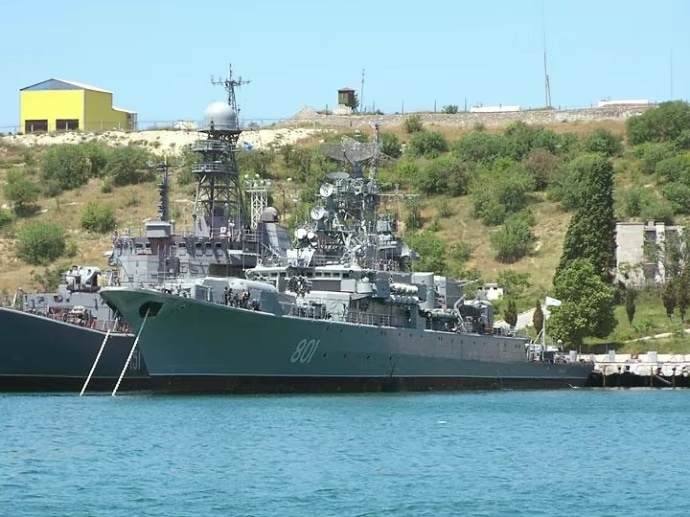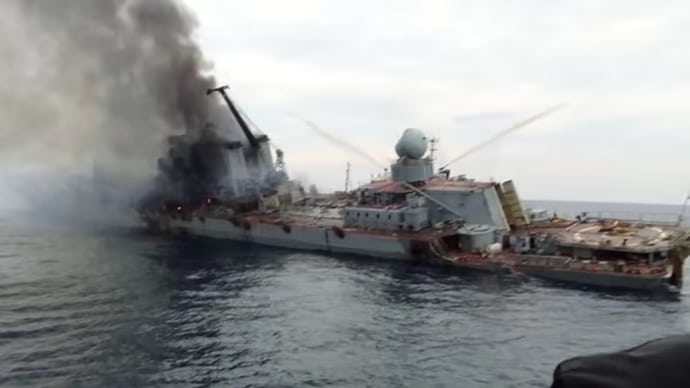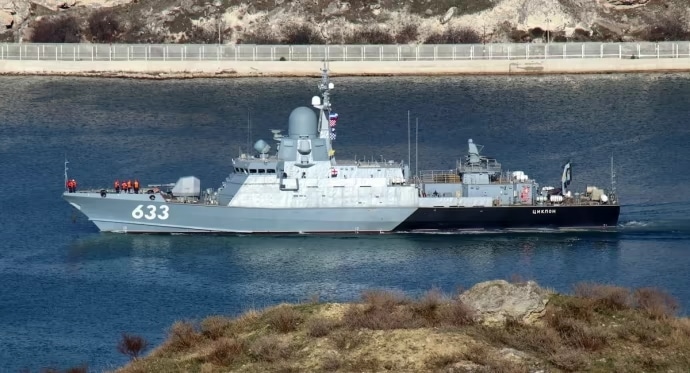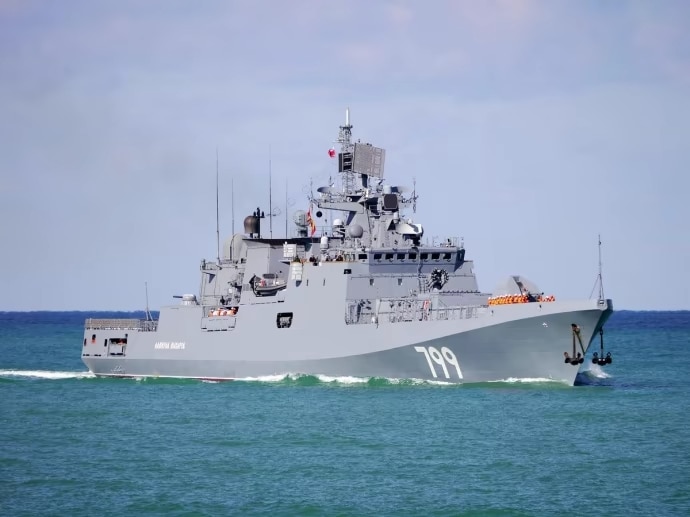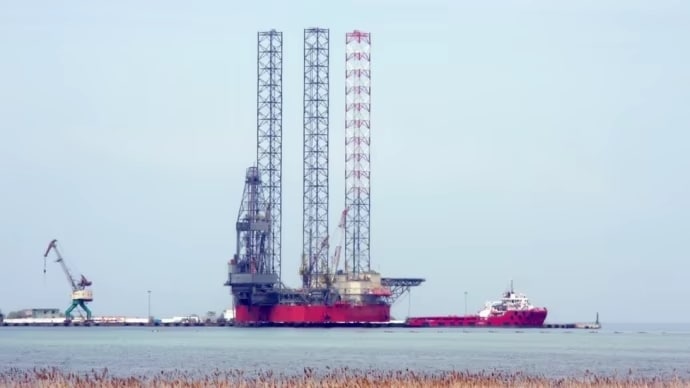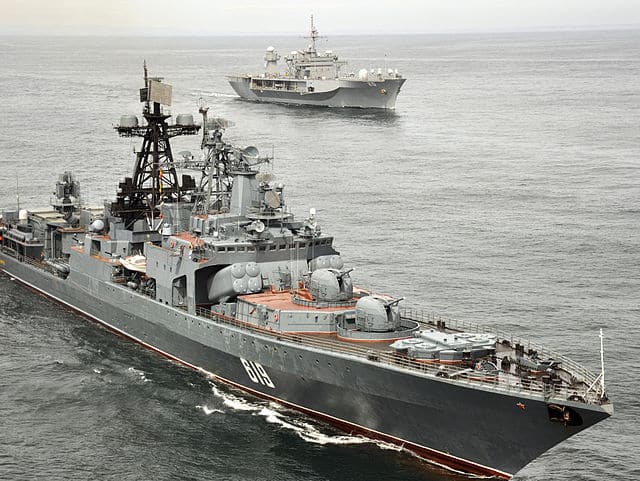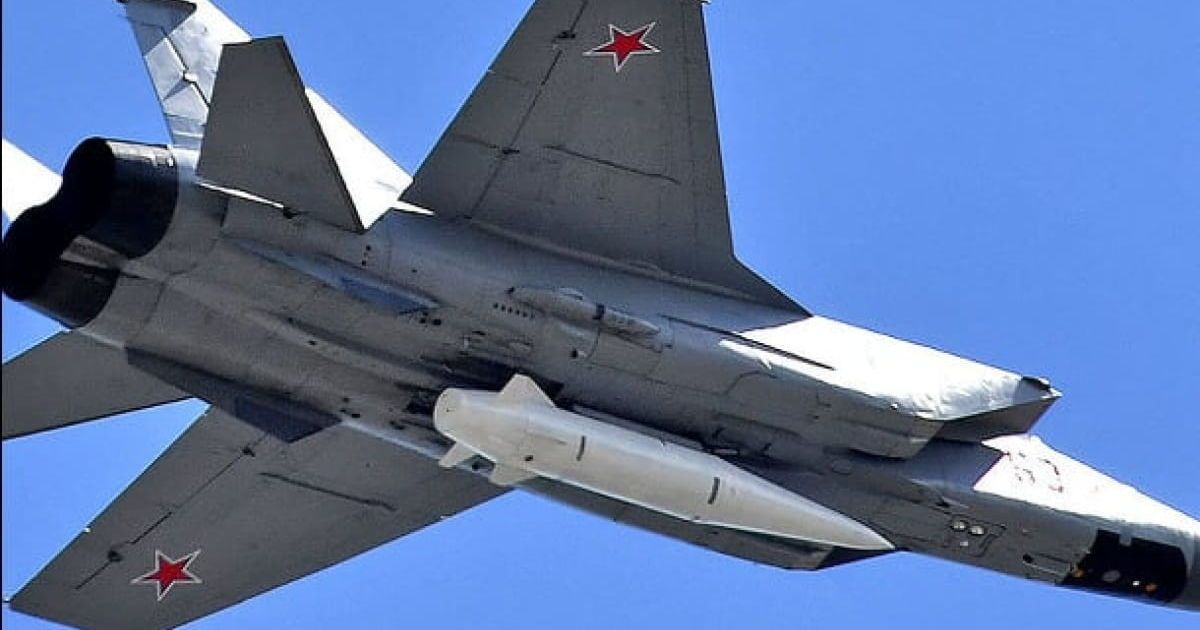Table of Contents
“Stop machine! Stop engine! Keep calm and listen to me!”
These words, spoken in terrifying English by armed Russian Marines in August, made headlines around the world. Russian military personnel stopped the ship Şükrü Okan flying the flag of Palau in the Black Sea, about 30 nautical miles from the Turkish coast. The vessel was supposedly headed to the Ukrainian city of Izmail and did not respond to “warning signals.”
In essence, this incident served as a clear confirmation of how Moscow intends to enforce its blockade of the humanitarian corridor, which it announced following the collapse of the “grain deal.”
Western experts interpreted these actions as an example of piracy in the 21st century. Such behavior is a stark indication of Russia’s nervousness over its inability to withstand attacks from Ukrainian drones targeting the “pride of Russia” — the Black Sea Fleet.
Ukrainska Pravda (media outlet) investigated the current state of the Russian Black Sea Fleet, which, since February 24, 2022, has gone from bravado in intimidating Ukrainian border guards near Snake Island to the sinking of the flagship Moskva, attacks on the fleet’s bases, and constant drone strikes from Ukrainian troops.
The fleet of discord
At the time of the Soviet Union’s dissolution, the Black Sea Fleet was considered one of the most materially well-equipped within the USSR. Its total fleet size, according to various estimates, ranged from 800 to 2000 vessels, with approximately 300 of them being combat-ready. It is these combat-ready vessels that we will focus on in this article.
It is not surprising that such military might become a source of discord between Kyiv and Moscow. The fleet could not be decisively divided until 1997 when the infamous Treaty of Friendship and Cooperation was signed between Ukraine and Russia. Concerning the Black Sea Fleet, the treaty clearly favored Russia, which acquired over 80% of the fleet’s assets, including ships.
Source: Ukrainska Pravda
While these arrangements cannot be considered favorable for Kyiv, they included several clauses that influenced the development (or rather, degradation) of the Black Sea Fleet in the following decades.
“First of all, it should be noted that there was an economic crisis at that time, and many ships could not be adequately maintained; they were sold for scrap metal. Additionally, under the terms of that treaty, Russia was not allowed to introduce new ships into Ukraine’s territorial waters, including Crimea,” explains an expert from the Sonata company, retired Captain of the First Rank, former Deputy Chief of Staff of the Ukrainian Navy, Andriy Ryzhenko.
Moreover, despite Vladimir Putin’s constant bravado, the aging and degradation of the Russian Black Sea Fleet continued during his presidency.
As of 2013, the Russian Black Sea Fleet had approximately 270 ships, of which only 46 were combat-ready (the others were support vessels).
Preparing for a major war
Everything changed with the occupation of Crimea in 2014. Russia significantly bolstered all components of the Black Sea Fleet at that time.
Moscow greatly increased its aviation presence in Crimea (currently housing around 150 aircraft alone), deployed coastal missile systems Bastion and Bal on the peninsula, equipped it with modern air defense systems, and began expanding its combat ship inventory.
“After the occupation of Crimea, they prioritized arming the Black Sea Fleet, which had the highest number of combat ships introduced into service. During this period, they introduced 3 frigates of the Admiral series (Admiral Makarov, Admiral Essen, and Admiral Grigorovich). They built 4 small missile ships of the Buyan-M project, retrofitting them with Kalibr missiles. They constructed several patrol ships of the Vasiliy Bykov type. They also built and deployed 6 submarines to Crimea,” explains Ryzhenko.
Overall, Russia intended to build 6 Admiral frigates of Project 11356P Burevestnik for the Black Sea Fleet. However, in 2014, the Mykolaiv-based state enterprise Zorya-Mashproekt ceased supplying gas turbines for these frigates, forcing Russians to sell the partially completed ships to India.
See also: How much more weapons does Russia have? Calculation of enemy losses and capabilities
Source: Ukrainska Pravda
Additionally, Russia began transferring combat ships from the Baltic and Northern Fleets to the Black Sea. For example, in early February 2022 (yes, precisely when Western intelligence was already on high alert), Russians deployed 6 large landing ships to the Black Sea under the guise of exercises. These included Kaliningrad, Minsk, Korolev, Petro Morgunov, Georgii Pobedonosets, and Olenegorsky Gornyak.
Considering that the Black Sea Fleet had 7 dock landing ships at that time, the landing potential in the Black Sea was effectively doubled in one stroke.
If one reads the previous seven paragraphs and compares them to the continuous missile attacks with Kalibr missiles, it may appear as though preparations for the full-scale war were remarkably evident in hindsight, but in real-time, all these signs were not…
From Moskva to Olenegorsky Gornyak
As of February 24, 2022, the Black Sea Fleet counted 74 combat ships. And if you add active assistance from other Russian fleets, the audacity displayed by the cruiser Moskva in its already legendary radio exchanges with the garrison on Snake Island should hardly surprise anyone.
Such relaxation and “swagger” in every known sense eventually played a cruel joke on the officers of the cruiser, which was hit by the Ukrainian Neptune missile in April 2022.
However, it is worth mentioning here the consequences for the Black Sea Fleet of losing its flagship.
“The purpose of this ship is 100% attack, and I don’t know why, but both in Georgia in 2008 and now in Ukraine, they used it more as a floating headquarters. Firstly, the sinking of the Moskva had a psychological impact. Putin’s favorite ship was a serious image loss. Secondly, we gave NATO a gift because we eliminated the threat to their aircraft carriers (fighting against aircraft carriers was the main task of the Moskva, according to its characteristics). Thirdly, it was a flagship where 50-70 officers could be accommodated. Now, there are no such capabilities. They designated the Admiral Makarov as the new flagship, which can carry 15 officers to sea,” explains Andriy Ryzhenko.
Source: Ukrainska Pravda
Surprisingly, the Russian command did not draw significant conclusions, and later, following the sinking of the Moskva, there was an attack on the port of Berdiansk, where the large landing ship Saratov was destroyed, while Novocherkassk and Cesar Kunikov miraculously avoided a similar fate.
These were just the initial losses for the Russian Black Sea Fleet. Later, due to direct missile strikes and attacks by surface and underwater drones, Ukraine inflicted significant damage to the numerical composition of the Russian fleet. This forced Russia to drastically limit its military operations in the Black Sea waters.
According to Ukrainian General Staff data, the current number of losses of ships and boats from the Russian Black Sea Fleet stands at 18 units. The most recent of them is the Olenegorsky Gornyak, which Ukrainian drones recently managed to locate in Novorossiysk.
However, this figure needs to be deciphered because not all of Russia’s losses in the Black Sea are irreversible.
“The ships Vasily Bekh, Saratov, and Moskva were definitely destroyed, and many Raptors and Serna (combat boats) were also destroyed, but some of the damaged ones were salvaged, like Admiral Makarov,” reminds Andriy Ryzhenko.
What remains in the Russian Black Sea Fleet and what Ukraine should pay attention to
Despite active engagements with Russian ships, it is premature to speak of a significant reduction in their number.
“In total, we estimate that there are up to 50 combat units in the Black Sea, but among them are those undergoing dry dock repairs. In terms of basing locations, if you include boats of various classes, there are up to 80 combat units in the Azov-Black Sea waters. Plus, add up to 20 units of border guards and the Russian FSB’s maritime security,” explains Dmytro Pletenchuk, spokesperson for the Ukrainian Navy.
One-third of the combat ships (mostly newer ones) are stationed in Novorossiysk, while two-thirds are in Sevastopol.
The most dangerous among them currently are the carriers of the Kalibr missiles, including 2 frigates, 3 Buyan-M corvettes, and 4 submarines. There are also older versions of combat ships armed with supersonic anti-ship missiles Moskit.
A separate topic is Russia’s desire to establish the Azov Sea naval district with headquarters in Mariupol.
According to the announced plan, it should consist of 8 combat ships and 16 support vessels. Among the combat ships, it’s worth noting the small missile boats Tsiklon, Askold, which are undergoing trials, and Amur, which is under construction. These ships from the Karakurt series, an enhanced version of the Buyan-M, are also equipped with Kalibr missiles, with a total salvo of 8 missiles per ship.
Russia believes that Karakurt class ships like the new Tsiklon will change the configuration of the front
Source: Ukrainska Pravda
The Tsiklon recently participated in an attack on Ukraine from the Sea of Azov a few days ago, launching 2 Kalibr missiles.
According to Andriy Ryzhenko, when considering the combat capabilities concentrated in the Black, Azov, and Caspian Seas, the maximum total salvo of Kalibr missiles could reach 100 missiles.
Another potential threat could come from a dozen large landing ships in the Russian Black Sea Fleet’s arsenal. Although they are not currently used for direct landing purposes, they are equipped with artillery and can employ multiple rocket launchers similar to Grad installations, with a total salvo of up to 400 rockets.
The last time these large landing ships were used was during the siege of Ukrainian forces in Mariupol when Russians attacked Azovstal Steel Works from the Sea of Azov in the spring of 2022. They could employ a similar tactic for strikes against advancing forces in the south if they approach closer to the coast.
Changes in Russian tactics in the Black Sea after Ukrainian strikes
After a series of successful strikes by Ukrainian drones, Russia is attempting to secure its bays with buoy barriers (a chain of buoys with a diameter of 1.5 meters designed to create obstacles for moving objects).
“They even wanted to place buoy barriers not only in the bays but also along the entire length of the Crimean Bridge, but they probably couldn’t find such a large quantity, so they sank pontoons or old ships in the non-navigational part of that channel,” explains Ryzhenko.
Additionally, measures to patrol the waters have been strengthened.
“There has been an increase in security measures in the Kerch Strait. There are usually no fewer than 10 units — 5-6 ships and 5-6 boats at the same time. Sometimes they are further reinforced with military ships,” says Dmytro Pletenchuk.
“It’s important that they are keeping their distance from our shores. They cannot approach closer than 100 nautical miles from our coastline. However, maritime aviation periodically operates in that area,” adds the spokesperson for the Ukrainian Navy.
The flagship of the Russian Black Sea Fleet, Admiral Makarov, does not appear on the high seas very often, so as not to repeat the fate of the Moscow
Source: Ukrainska Pravda
Currently, experts do not see the need for Russia to increase the number of combat ships in the Black Sea. Although there are theoretical possibilities for transferring ships from the Caspian Sea through the Sea of Azov, including via the Volga-Don Canal.
The main limitation of the canal is the unstable depth of the fairway, which allows for the passage of vessels with a draft of up to 4 meters. Theoretically, only small missile boats or, in certain conditions, large dock landing ships could meet these criteria. According to sources cited by Ukrainska Pravda in the Ukrainian Navy, Russia has used this canal successfully on several occasions, but there have also been failures.
Key points in the Black Sea
Tensions in the Black Sea have increased following Russia’s disruption of the “grain deal.”
“I can’t say that Russians’ tactics have changed critically in the Black Sea. In principle, they are operating in the same manner as usual. However, at one point, Vasiliy Bykov and Pytlivyy frigates attempted to block the area between Turkey and Bulgaria. They claimed to be blocking a supposedly neutral area for firing exercises. They even detained a Turkish ship,” explained Pletenchuk.
Experts also consider the sector of Snake Island and the area near the Boyko towers which were seized by Russia in 2014, as crucial points in the Black Sea.
Source: Unian
“Snake Island is the key to the Danube and the key to the ports of Odesa. Without its liberation, I think there would have been no grain deal. There would have been no navigation on the Danube. The lifeline of navigation is only possible when Russia does not control it,” emphasized Andriy Ryzhenko.
In turn, the Boyko towers are important not only for gas extraction but also for surface and underwater surveillance using radio reconnaissance equipment. This is why battles are already taking place for them, similar to what was observed after Independence Day.
What can Ukraine do?
“Drones work well when used for the first time. Drones are a successful and effective addition to the concept of the ‘mosquito fleet,'” ponders Andriy Ryzhenko.
However, he adds that their effectiveness lies in the element of surprise, so tactics need to be constantly changed when using them.
“We need small ships, 20-50 meters in length, which could, firstly, project force through missile strikes against the aggressor, secondly, protect ports, clear sea mines, and prevent enemy sabotage raids. And thirdly, conduct assault and reconnaissance raids themselves, such as amphibious and special operations,” continues the expert.
As an example of a successful raid, Ryzhenko cites the recent special operation near Tarkhankut, emphasizing that the patrol boats Mark VI would have been very helpful, as the US planned to transfer them to Ukraine in January 2023.
Overall, according to him, the main problem in naval warfare against Russia lies in the occupation of Crimea itself because the peninsula, due to its geographical location, provides a base for the fleet.
“The main obstacle is the unsinkable aircraft carrier, which is Crimea in the hands of the occupier,” emphasizes Ryzhenko.
He adds that the key to the peninsula primarily lies on land, as throughout history, it has always been liberated through land routes.
Originally posted by Yevhen Buderatsky on Ukrainska Pravda. Translated and edited by the UaPosition – Ukrainian news and analytics website
See also: The Ukrainian fleet that is needed “for yesterday”


